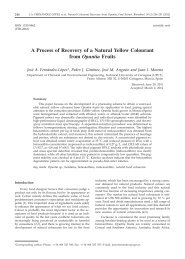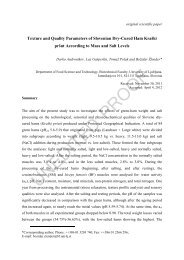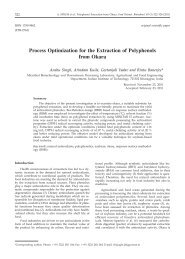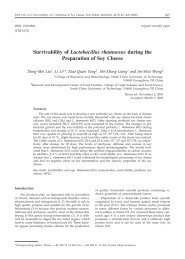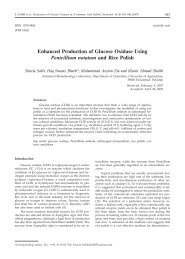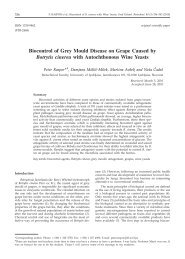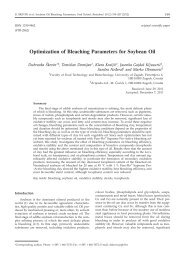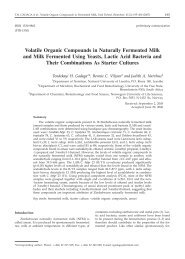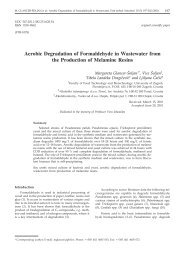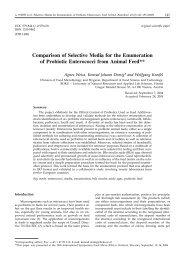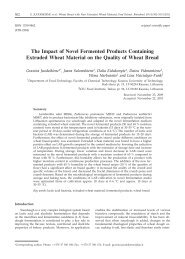a-Amylase Production by Bacillus amyloliquefaciens Using Agro ...
a-Amylase Production by Bacillus amyloliquefaciens Using Agro ...
a-Amylase Production by Bacillus amyloliquefaciens Using Agro ...
You also want an ePaper? Increase the reach of your titles
YUMPU automatically turns print PDFs into web optimized ePapers that Google loves.
D. GANGADHARAN et al.: a-<strong>Amylase</strong> Produced <strong>by</strong> B. <strong>amyloliquefaciens</strong>, Food Technol. Biotechnol. 49 (3) 336–340 (2011)<br />
with the highest aeration (Fig. 3). The yield reached maximum<br />
at 16 h and remained constant throughout the<br />
stationary phase. Biomass yield at 0.2 vvm aeration was<br />
0.6 mg/g at the initial growth phase and reached 1.1<br />
mg/g in the stationary phase. At 0.5 vvm, it increased<br />
to 1.03 mg/g in the initial growth phase and reached a<br />
maximum of 1.38 mg/g. Maximum yield (2.4 mg/g)<br />
was obtained at 1.0 vvm aeration. The productivity of<br />
a-amylase was maximum (41.4 U/(mL·h)) at the beginning<br />
of the log phase with maximum aeration during<br />
the fermentation period of 14 h. High rate of production<br />
was observed throughout the log phase in all the bioreactors<br />
and gradually decreased towards the end of the<br />
log and stationary phases. Maximum obtained productivity<br />
was 11.75 in bioreactor A and 22.7 U/(mL·h) in<br />
bioreactor B.<br />
w(biomass)/(mg/g)<br />
3.0<br />
2.5<br />
2.0<br />
1.5<br />
1.0<br />
0.5<br />
0<br />
0 3 12 14 16 18 20 22 36 40 42 44 46 48<br />
Fermentation time/h<br />
Fig. 3. Comparison of productivity with biomass yield at different<br />
rates of aeration in parallel fermentor system. Productivity<br />
() and biomass yield () levels at 1.0 vvm in bioreactor C;<br />
productivity () and biomass yield () levels at 0.5 vvm in<br />
bioreactor B; productivity () and biomass yield () levels at<br />
0.2 vvm in bioreactor A<br />
<strong>Production</strong> of a-amylase in 5-litre fermentor<br />
The a-amylase production in 5-litre Biostat B-5 fermentor<br />
was studied at high rate of aeration of 1.5 vvm<br />
and impeller speed of 400 rpm. With the large volume<br />
of air, intense agitation and rich medium, foaming becomes<br />
a problem, thus the agitation level was maintained<br />
at 400 rpm. The analysis of enzyme and biomass<br />
production at equal time intervals showed maximum<br />
enzyme ((1112±3.4) U/mL) and biomass production (32<br />
mg/mL) after 42 h of fermentation. In an earlier report<br />
(24), the production of a-amylase was studied in a 7.5-<br />
-litre fermentor with a working volume of 3 L <strong>by</strong> amplified<br />
variants of B. subtilis and B. <strong>amyloliquefaciens</strong>. The<br />
study demonstrated maximum production of the product<br />
and growth rate at high aeration rate (3 vvm) and<br />
agitation speed (300 rpm). Syu and Chen (25) described<br />
the production of a-amylase <strong>by</strong> B. <strong>amyloliquefaciens</strong> in a<br />
1.7-litre fermentor at high rates of aeration. The residual<br />
sugar obtained at the end of the fermentation was (0.8±<br />
0.01) mg/mL (data not shown), which denoted efficient<br />
utilization of substrate for growth and a-amylase production.<br />
In the scale-up of aerobic processes, it is often observed<br />
that the biomass yield on the carbon/energy<br />
source is decreased. In an E. coli-based recombinant pro-<br />
45<br />
40<br />
35<br />
30<br />
25<br />
20<br />
15<br />
10<br />
5<br />
0<br />
Productivity/(U/(mL·h))<br />
tein process, the biomass yield on glucose and the maximum<br />
cell density dropped <strong>by</strong> about 20 % when scaled<br />
up from 3 L to 9 m 3 (26). In the present study, the productivity<br />
of a-amylase (40 U/(mL·h) and the biomass<br />
yield (2.5 mg/g) were the highest at 12 h of fermentation<br />
(Fig. 4). The maximum biomass yield and productivity<br />
values in the 600-mL fermentor at an aeration rate<br />
of 1 vvm were comparable but obtained only after 14 h<br />
of fermentation. The biomass yield remained constant<br />
throughout the post-logarithmic and stationary phases<br />
indicating efficient substrate utilization <strong>by</strong> the microorganism<br />
until it reached the stationary phase. Hessleink<br />
(27) reported that the catalytic activities of an organism<br />
could be fully utilized if the oxygen levels in the immediate<br />
vicinity of the cells were maintained through aeration<br />
and agitation. Higher levels of agitation could also<br />
cause disruption of free cells in the reactor <strong>by</strong> shear forces<br />
and the formation of vortex could result in poor mass<br />
transfer and thus reduced enzyme titres (28,29).<br />
Productivity/(U/(mL·h)<br />
45.0<br />
40.0<br />
35.0<br />
30.0<br />
25.0<br />
20.0<br />
15.0<br />
10.0<br />
5.0<br />
0.0<br />
Conclusion<br />
The physical and biological factors in a fermentation<br />
process have an important role in enhancing the enzyme<br />
yields. The present study demonstrates the importance<br />
of aeration and agitation on biomass yield and enzyme<br />
production in a scale-up process. The enzyme production<br />
profile clearly demonstrates a growth-related pattern.<br />
This study also encourages the effective utilization<br />
of agroresidual substrates for large scale industrial processes.<br />
Acknowledgement<br />
The authors are thankful to Department of Biotechnology<br />
(DBT), Ministry of Science and Technology, New<br />
Delhi, India, for the financial assistance.<br />
References<br />
0 6 12 18 24 36 42 48<br />
Fermentation time/h<br />
339<br />
Fig. 4. a-<strong>Amylase</strong> productivity () and biomass yield () <strong>by</strong>B.<br />
<strong>amyloliquefaciens</strong> at 1.0 vvm in a 5-litre fermentor<br />
1. C.R. Harwood, <strong>Bacillus</strong> subtilis and its relatives: Molecular<br />
biological and industrial workhorses, Trends Biotechnol. 10<br />
(1992) 247–256.<br />
2. E. Ferrari, A.S. Jarnagin, B.F. Schmidt: Commercial <strong>Production</strong><br />
of Extracellular Enzymes. In: <strong>Bacillus</strong> subtilis and Other<br />
Gram-Positive Bacteria: Biochemistry, Physiology, and Molecular<br />
Genetics, A.L. Sonenheim, J.A. Hoch, R. Losick (Eds.),<br />
American Society for Microbiology Press, Washington DC,<br />
USA (1993) pp. 917–937.<br />
3.0<br />
2.0<br />
1.0<br />
0.0<br />
w(biomass)/(mg/g)




